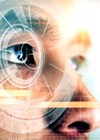As the application of artificial intelligence (AI) is brought to the foray of clinical medicine, you can be forgiven for thinking that it is a relatively recent technology. However, researchers and computer scientists have been working on it for many decades.
I attended the artificial intelligence, deep learning, and machine learning in ophthalmology conference hosted by the Royal Society of Medicine. Geoffrey Hinton, who is considered a leader in the field of AI and large-language models (LLMs), was the keynote speaker. The Turing Award winner discussed how he popularised backpropagation in 1986, which is vital to the LLMs used today [1]. He also discussed the similarities and differences between digital and biological computation. We also heard from other speakers who discussed clinical application of AI within ophthalmology.

An exciting use of AI within ophthalmology is oculomics, which was touched upon during the conference. Oculomics quite literally stands by “the eye is the window into the soul.” The principle utilises data taken from measurements of the eye and uses large data models to extract systemic health data about the person.
Utilising large data sets and deep learning, information can be extracted from the variety of imaging conducted within ophthalmology. Geoffrey Hinton, a pioneer of deep learning, discussed how it is a subset of machine learning that utilises more complex neural networks to undertake enriched tasks.
A recent development within oculomics and AI is the RETFound model, which was created by a group of researchers and clinicians at UCL and Moorfields Eye Hospital. Pearse Keane, Professor of Artificial Medical Intelligence, lead the development of this model, and presented his work at the conference. As a foundation model, RETFound has multiple functions. Foundation models are large AI models, that use deep neural networks, which can be tweaked to work in a variety of scenarios. The benefit of such models is cost-effectiveness and quicker outcomes. The field of oculomics benefits from foundation models to analyse data in a flexible manner, allowing inference of a wide range of local and systemic conditions.
However, a key difficulty with large models is the requirement for very specific and detailed labelling, which is often done manually, and can be time and resource consuming. The excitement surrounding foundational models is that it can learn from unlabelled retinal images, in a process called self-supervised learning [2].
The function of disease prediction through observation of biomarkers is utilised extensively in genomics, but oculomics is still a novel field. However, RETFound has demonstrated the viability and function of this practice. Whilst still a limited and early technology, RETFound showed great potential with detection of heart failure, ischaemic stroke and Parkinson’s disease, as well as identification of eye-specific diseases such as glaucoma and diabetic retinopathy [3].
Healthcare is often considered as data rich, but context poor. And a key excitement for oculomics and wider AI is the development and use of deep foundation models. Self-supervised learning reduces the burden of training generalised AI models, and often results in more accurate outcomes. Further, the excitement lies with the potential for discovery of new biomarkers and data indicators which could help diagnosis and help manage a variety of systemic conditions that aren’t directly obvious.
For information on the next meeting, visit: https://ophthalmos.ai
References
1. Rumelhart DE, Hinton GE, Williams RJ. Learning representations by back-propagating errors. Nature 1986;323(6088):533–6.
2. Krishnan R, Rajpurkar P, Topol EJ. Self-supervised learning in medicine and Healthcare. Nat Biomed Eng 2022;6(12):1346–52.
3. Zhou Y, Chia MA, Wagner SK, et al. A foundation model for generalizable disease detection from retinal images. Nature 2023;622:156–63.
COMMENTS ARE WELCOME











